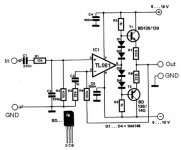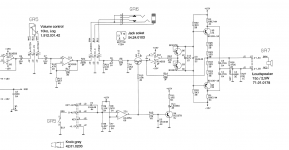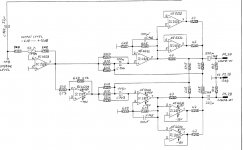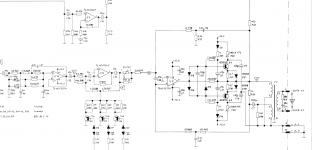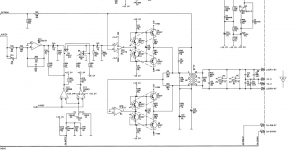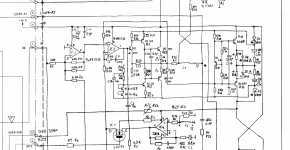This thread is ripe with examples of:
Four stages of competence - Wikipedia
and the Dunning-Kruger effect:

As is most of DIYA.
Four stages of competence - Wikipedia
and the Dunning-Kruger effect:

As is most of DIYA.
White buffer
1: White buffer to reduce distortion.
2. Bootstrap input bias to increase the input impedance.
Well, it's a buffer that could use:Here you go. Audio perfection.
1: White buffer to reduce distortion.
2. Bootstrap input bias to increase the input impedance.
Attachments
82R really ?
Best not to overthink it. Simply following the logic of this thread so it is not a serious proposal. Picked it up off the net, save me drawing anything, the only criteria being one active device.
Well, it's a buffer that could use:
1: White buffer to reduce distortion.
2. Bootstrap input bias to increase the input impedance.
Like Mr Johnson, it is not meant to be taken seriously. Would have thought the reference to perfection would give the game away.This is, after all, the lounge.
Solid State Circuits 5
This thread is ripe with examples of:
Four stages of competence - Wikipedia
and the Dunning-Kruger effect:
As is most of DIYA.
Would that include thinking a BC109 is a serious proposal for audio perfection ?
You're welcome.
For really stubborn parts, I've even used something like this - I only use a torch when I don't care about the board the parts are on - salvage:
Also, For what it's worth, I use superwick.
The hint about high temperature is right in the description: "No-Clean Super Wick™ is a tightly woven, oxide-free copper braid coated with a high activation temperature no-clean flux. Its high purity and tight weave make it fast-wicking, quickly removing solder and minimizing dwell time."
400-NS Series - No Clean Super Wick - Desoldering Braids | MG Chemicals
Thank you very much again. I will try again this braid you mention. Mine was very cheap one ... i do not remember the brand. I had issues with the desoldering gun ... but i used it very little. I have to find time to practice again. I have some old amps to use ... my idea is to simply transform some already decent integrateds that almost no one consider in even more decent power amps. I always use separate preamps ... i have this feeling that tone controls switches and volume controls often they mess up the sound quite a bit, especially in cheap integrateds. With the power section being very very decent in some cases
Thanks a lot again.
Last edited:
Look my friend! here's the Nakamichi Dragon headphones amplifier. Although a Nakamichi classic this was the worst ever sounding thing made by Nakamichi but it was only used for monitoring the recording level. Everybody else is using the line out for listening...
If you really want a good headphone amplifier Tandberg 3014 is the one.
if you're curious about the prodigy child upstairs, go with Yamaha kx930 opamp variation.
If you really want to know waht professionals use go with Studer A820 who's headphones amp is the industry standard
Hi ! thanks a lot but wait ... which is which ? let's say that i am very interested in the headphone thing ... which is the Tandberg and which the Studer ? anyway the search for the manuals is on ...

Have a nice day 😉😀
nakamichi, tandberg, yamaha from left to right.studer a820/a827not figured...it's a few hundred pages manual to look into...but most professional soundcards have the same headphones amp in it, the most classical one . smth like this one: Headphone Amplifier
Last edited:
nakamichi, tandberg, yamaha from left to right.studer a820/a827not figured...it's a few hundred pages manual to look into...but most professional soundcards have the same headphones amp in it, the most classical one . smth like this one: Headphone Amplifier
Thanks ! sorry do you mean that the one attached is the industry's standard headphone amp ? 😱 that simple ? 🙁
😀

Attachments
although i've downloaded about 10 studer partd of those manjuals i couldn't find the actual headphones amp, but i found some related schematics.
Attachments
Thanks a lot. So even in Studer they were not alergic to opamps ... 😀although i've downloaded about 10 studer partd of those manjuals i couldn't find the actual headphones amp, but i found some related schematics.
very good 😉
Now maybe the issue is how the opamps are powered ? For instance ... are fixed voltage regulators completely fine ?
i am asking because i have some noise in a preamp who use them.
Unfortunately i do not have a spectrum analyzer to check the components of this noise ... but it is not a hum ... more a hiss
And i understand fixed voltage regulators usually have low performance of noise rejection at higher Hz ... maybe it is noise coming from the mains and leaking through the power supply ? but without measuring is hard to tell 🙁
i managed in the past to make phono preamps and tape head preamps with no regulator at all just very careful filtering , shielding and grounding. I showed you in the other topic the Studer smps power supply...if you want really good power supplies go check the technics sl-p1000 service manual.
i have this feeling that tone controls switches and volume controls often they mess up the sound quite a bit, especially in cheap integrateds. With the power section being very very decent in some cases
In my experience this is true.
Every penny must be saved. Cheapest op amps, noisy resistors, cheapest of the cheap volume controls, etc.
It's not that hard to build a full function line level stage - volume, balance, bass, treble - that doesn't muck up the sound. But you'll spend more on the volume control than the big guys spend on the whole circuit. You'll spend more on one resistor than the big guys pay for 25 resistors. You'll have to pony up for film capacitors - you might spend as much as a dollar for one capacitor.
Commercial equipment is built to a price point. If it wasn't then it would be quite expensive. Go down to your local snooty high end hi fi store and see how much a Pass power amp sets you back. 😱 That's what it costs to manufacture equipment that has all the right stuff in it.
Last edited:
It's not that hard to build a full function line level stage - volume, balance, bass, treble - that doesn't muck up the sound. But you'll spend more on the volume control than the big guys spend on the whole circuit. You'll spend more on one resistor than the big guys pay for 25 resistors. You'll have to pony up for film capacitors - you might spend as much as a dollar for one capacitor.
What you didn't mention is...
Manufacturing corporations buy and sell in quantity.
Of course the DIY'er pays more for say, a single high quality potentiometer.
When corporations order perhaps thousands - at discounted bulk quantities.
i managed in the past to make phono preamps and tape head preamps with no regulator at all just very careful filtering , shielding and grounding. I showed you in the other topic the Studer smps power supply...if you want really good power supplies go check the technics sl-p1000 service manual.
 ... cannot find it 😱
... cannot find it 😱
Last edited:
In my experience this is true.
Every penny must be saved. Cheapest op amps, noisy resistors, cheapest of the cheap volume controls, etc.
It's not that hard to build a full function line level stage - volume, balance, bass, treble - that doesn't muck up the sound. But you'll spend more on the volume control than the big guys spend on the whole circuit. You'll spend more on one resistor than the big guys pay for 25 resistors. You'll have to pony up for film capacitors - you might spend as much as a dollar for one capacitor.
Commercial equipment is built to a price point. If it wasn't then it would be quite expensive. Go down to your local snooty high end hi fi store and see how much a Pass power amp sets you back. 😱 That's what it costs to manufacture equipment that has all the right stuff in it
Hi ! thanks a lot again for the very valuable advice.
I think that many British manufacturers had the right approach in the early '80s. No tone control ... just a inputs selector and a volume and the power switch. And i understan this paid in terms of sound quality.
I am not against eq ... problem maybe it is to do it right ? i do not know. It is complex.
And moreover often a real preamp stage is not needed at all in an integrated. Preamps are for people who wants to play with cables, different power amps ... like me i mean 😱
Placing a very good passive attenuator of the right value makes a very good power amp a great integrated.
This is what i would like to do if i cannot be able to make a decent line preamp. This story of the line preamp is obsessing me. Very much.
- Home
- Member Areas
- The Lounge
- Overengineering in audio equipment

